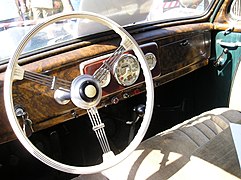You can help expand this article with text translated from the corresponding article in Finnish. (November 2015) Click [show] for important translation instructions.
|
| Tatra 57 | |
|---|---|
 | |
| Overview | |
| Manufacturer | Závody Tatra |
| Production | 1932–1949 T 57: 1932–36 T 57A: 1936–38 T 57B: 1938–49 |
| Body and chassis | |
| Class | compact car |
| Body style | two-door sedan, convertible or coupé |
| Layout | FR layout |
| Chassis | backbone chassis |
| Related | Austro-Tatra 57 L |
| Powertrain | |
| Engine | 1,155 cc, 18 hp (13 kW) flat-four T 57A: 1,155 cc, 20 hp (15 kW) |
| Dimensions | |
| Length | 3,500 mm (137.8 in)[1] |
| Width | 1,500 mm (59.1 in) |
| Height | 1,500 mm (59.1 in) |
| Curb weight | 730 kg (1,609 lb) |
| Chronology | |
| Predecessor | Tatra 12 |
The Tatra 57 are a series of two-door compact cars, built by Czechoslovakian company Tatra[1] from 1932. They are popularly known by the nickname "Hadimrška".
Tatra updated the model as the 57A in 1936, and as 57B in 1938. A military adaptation, the 57K, (for Kübelwagen) was introduced in 1941. Through 1945, more than 5,000 Tatra Kübelwagens were built.[2]
All versions have a characteristic Tatra backbone chassis, with the drive-shaft running encased in its central structural tube.
Tatra ended production of the 57K in 1947, and of the 57B in 1949. With that the company altogether withdrew from making compact cars; from 1948 its smallest model was the 2 litre Tatra 600.
-
Tatra 57B flat four engine.
-
Tatra 57 (left) and Tatra 11 (right).
-
Tatra 57B interior.
- ^ a b "Documentace Tatra". Klub Vojenského Muzea. 21 November 2010.
- ^ Cite error: The named reference
KfzWehrT57was invoked but never defined (see the help page).


